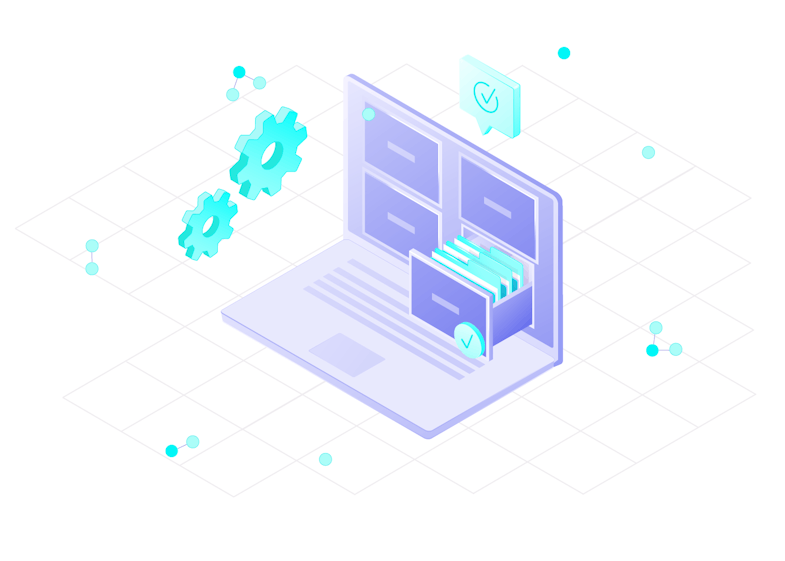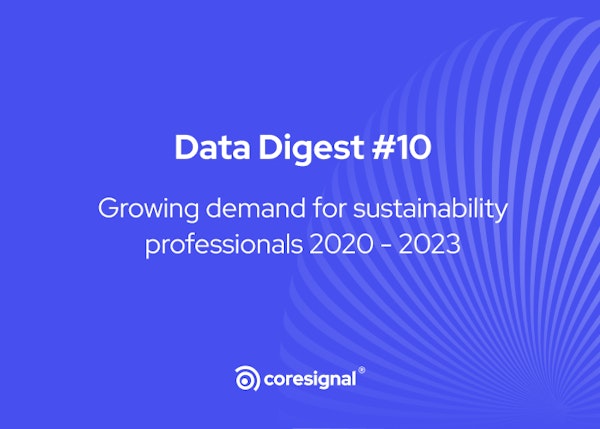Professional network data
Leverage our top B2B datasets
Job posting data
Get access to hundreds of millions of jobs
Employee review data
Get data for employee sentiment analysis
Clean dataNEW
Enhanced professional network data
Employee data
Get data on global talent at scale
Funding data
Discover and analyze funding deals
Firmographic data
Unlock a 360° view of millions of companies
Technographic data
Analyze companies’ tech stacks
BY INDUSTRY
MOST POPULAR USE CASES
Investment
Leveraging web data for informed investing
HR tech
Building or enhancing data-driven HR tech
Sales
Supercharging your lead generation engine
Marketing
Transforming marketing with web data
Market research
Conducting comprehensive market research
Lead enrichment
Use Coresignal’s data for enrichment
Talent analytics
Analyze talent from multiple perspectives
Talent sourcing
Comprehensive talent data for recruitment
Investment analysis
Source deals, evaluate risk and much more
Target market analysis
Build a complete view of the market
Competitive analysis
Identify and analyze competitors
B2B Intent data
Lesser-known ways to find intent signals
BY INDUSTRY
MOST POPULAR USE CASES
Investment
Leveraging web data for informed investing
HR tech
Building or enhancing data-driven HR tech
Sales
Supercharging your lead generation engine
Marketing
Transforming marketing with web data
Market research
Conducting comprehensive market research


Susanne Morris
June 2, 2022
Analysts and investors rely on data for everyday decision-making processes. Data can elevate investment decisions, improve AI-based recruitment, and even streamline business operations. However, well-structured data is difficult to come by, as there are many barriers when it comes to obtaining standardized and easy-to-read datasets. Luckily, data normalization offers a solution to this problem.
What is data normalization?
Database normalization is the process of structuring a database according to what’s called normal forms, with the final product being a relational database, free from data redundancy. More specifically, normalization involves organizing data based on assigned attributes as a part of a larger data model. The main objective of database normalization is to eliminate redundant data, minimize data modification errors, and simplify the query process.
Ultimately, normalization goes beyond simply standardizing data, and can even improve workflow, increase security, and lessen costs. This article will unpack the significance of database normalization, its basic structure, as well as the advantages of normalization. Let’s first take a look at why normalization is important and who uses it.
The main objective of database normalization is to eliminate redundancy, minimize data modification errors, and simplify the query process.
Why is normalization important?
Data normalization is an essential process for professionals that deal with large amounts of data. For example, crucial business practices such as lead generation, AI and ML automation, and data-driven investing all rely on large sums of data and relational database records. If the database is not organized and normalized, something as small as one deletion in a data cell can set off a sequence of errors for other cells throughout the database. Essentially, in the same way as data quality accounts for the accuracy of the information, data normalization accounts for the organization of said information.
5 advantages of data normalization
Let's take a look at some of the advantages of data normalization.
- Improved overall database organization
After normalization, your database will be structured and arranged in a way that is logical for all departments company-wide. With increased organization, duplication and location errors will be minimized and outdated versions of data can be more easily updated. - Data consistency
Consistent data is crucial for all teams within a business to stay on the same page. Data normalization will ensure consistency across development, research, and sales teams. Consistent data will also improve workflow between departments and align their information sets. - Reduces redundancy
Redundancy is a commonly overlooked data storage issue. Reducing redundancy will ultimately help reduce file size and therefore speed up analysis and data processing time. - Cost reduction
Cost reduction due to normalization involves a culmination of the previously mentioned benefits. For instance, if file size is reduced, data storage and processors won’t need to be as large. Additionally, increased workflow due to consistency and organization will ensure that all employees are able to access the database information as quickly as possible, saving time for other necessary tasks. - Increased security
Because normalization requires that data is more accurately located and uniformly organized, security is significantly increased.

Who uses normalization?
While database normalization may seem conflated with computer jargon, you’d be surprised how many professionals utilize the normalization process. Essentially, all software-as-a-service (SaaS) users can benefit from database normalization. This includes people that regularly parse, read, and write data, such as, data analysts, investors, and sales and marketing experts.
Implementing normalization throughout your databases, regardless of your business type (B2B, B2C, or an agency), will most likely see improvements in workflow optimization, file size, and even cost. But what exactly is normalization?

The data normalization process
Normalization organizes columns (attributes) and tables (relations) of a database according to a set of normal form rules. These normal forms are what guide the normalization process, and can be viewed as a sort of check and balance system that maintains the integrity of dependencies between the attributes and relations. The normalization process aims to ensure, through a set of rules (normal forms), that if any data is updated, inserted, or deleted, the integrity of the database stays intact.
Most common types of keys
There are four most common types of keys:
- Primary key is a single column that is used to recognize the table.
- Composite key is several columns used to recognize the rows in the table.
- Foreign key links the primary key that is in another table.
- Candidate key is a particular field in a relational database.
So what exactly are normal forms?
Normal forms were first introduced in the 70s by Edgar F. Codd, as a part of a larger organizational model for the standardization of relational database structures. As previously mentioned, normal forms, at their core, reduce data redundancy and aim to create a database free from insertion, update, and deletion anomalies. Normal forms do this by singling out anomalies that undermine the dependencies between attributes and relations and editing them to fit a standardized format that satisfies sequential normal forms.
After years of advancement and refinement, data normalization has six normal forms, known as 6NF; however, most databases are considered normalized after the third stage of normalization, known as 3NF. Going further, we will focus on normal forms 1NF through 3NF, as they are the primary stages of normalization. It’s also important to note that normalization is a cumulative process. For instance, in order to move onto the second normal form (2NF), the first normal form (1NF) must be satisfied. With that said, let’s get started with normal forms.
First normal form (1NF)
The first normal form is the foundation of the rest of the normalization process. It is referred to as the primary key and involves minimizing attributes and relations, columns and tables respectively. To do this, one must first start by removing any duplicate data throughout the database. Removing duplicate data and satisfying the 1NF includes:
- There is a primary key - no duplicate n values within a list or sequence.
- No repeating groups.
- Atomic columns - cells have a single value and each record is unique.
Second normal form (2NF)
Once 1NF is satisfied, one can move on to 2NF. The second normal form requires that subgroups of data that exist in multiple rows of tables are removed and represented in a new table with connections made between them. Essentially, all subsets of data that can exist in multiple rows should be put into separate tables. Once this is done relationships between the new tables (the subgroups of data that were rearranged) and new key labels can be created.
- 1NF is satisfied.
- Removes partial dependencies - relations (tables) with a primary key containing two or more attributes are relocated to a new table with new key labels created that correspond to a primary key.
Third normal form (3NF)
Following the logic of 2NF, the third normal form also requires that 1NF and 2NF are satisfied. 3NF states that no non-primary key attribute (column) should have transitive functional dependencies on the primary key. Therefore if the primary key is substituted, inserted, or deleted then all the data (that is transitively dependent upon that primary key), must be put into a new table.
- 1NF and 2NF are satisfied.
- There is no transitive dependency for non-primary attributes.
Fourth normal form (Boyce Codd Normal Form) and beyond
While normalizing your database in accordance with 4NF, 5NF, and 6NF, is recommended, most relational databases do not require more than 3NF to be satisfied to be considered normalized. The benefits of data normalization beyond 3NF don’t always cause significant errors when there are updates, deletions, or insertions of data. However, if your company utilizes complex datasets that get changed frequently, it is recommended that you also satisfy the remaining normal forms.

Wrapping up
In all, data normalization is an essential part of business for all those dealing with large datasets. Not only is it important to obtain quality data, but it is also important to maintain it through normalization. Analysts, recruiters, and investors alike will benefit from data normalization.
Don’t miss a thing
Subscribe to our monthly newsletter to learn how you can grow your business with public web data.
By providing your email address you agree to receive newsletters from Coresignal. For more information about your data processing, please take a look at our Privacy Policy.

Related articles

Sales & Marketing
10 Most Reliable B2C and B2B Lead Generation Databases
Not all lead databases are created equal. Some are better than others, and knowing how to pick the right one is key. A superior...
Mindaugas Jancis
April 23, 2024

Sales & Marketing
It’s a (Data) Match! Data Matching as a Business Value
With the amount of business data growing, more and more options to categorize it appear, resulting in many datasets....
Mindaugas Jancis
April 9, 2024

Data Analysis
Growing demand for sustainability professionals 2020 - 2023
Original research about the changes in demand for sustainability specialists throughout 2020-2023....
Coresignal
March 29, 2024